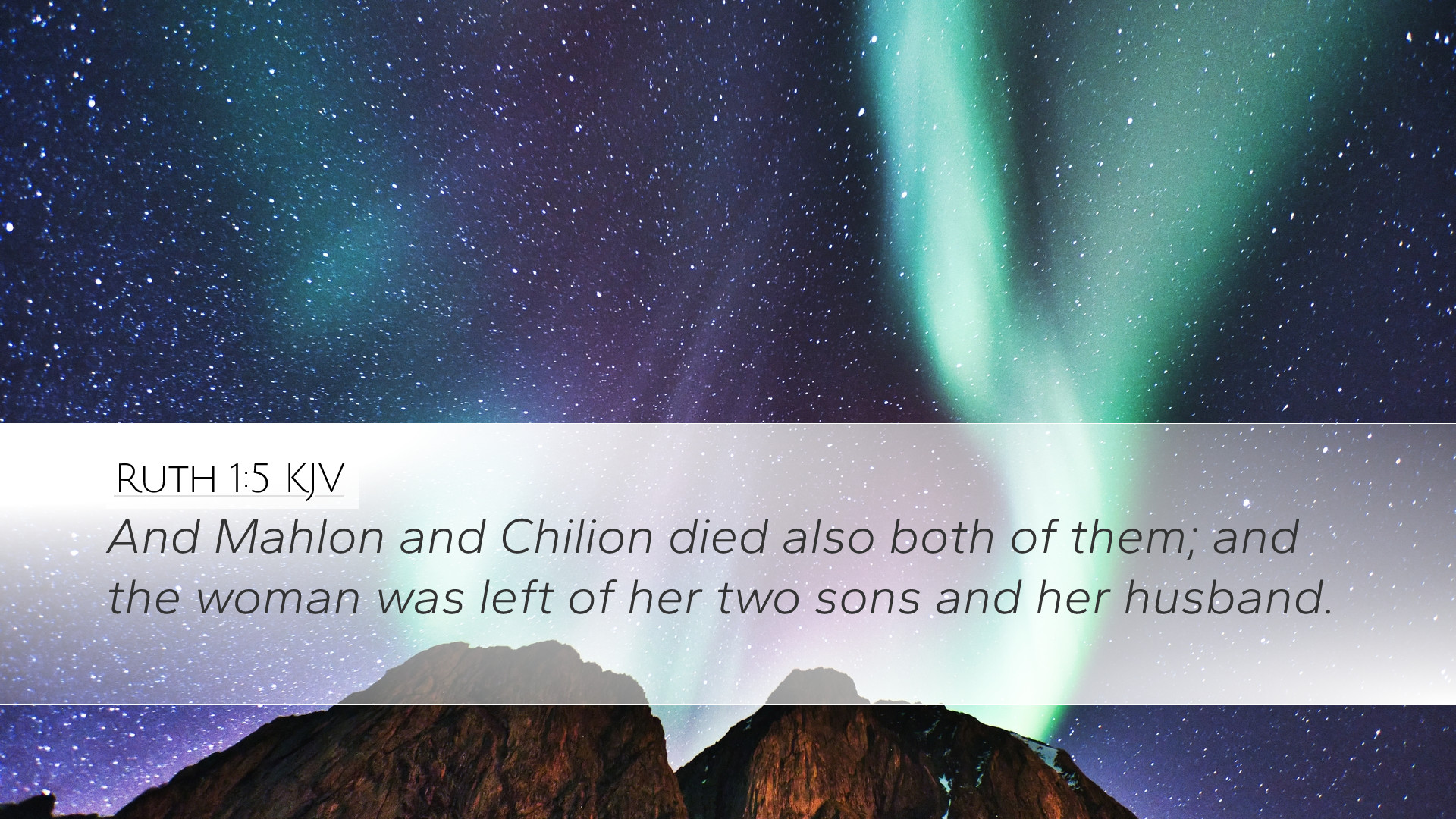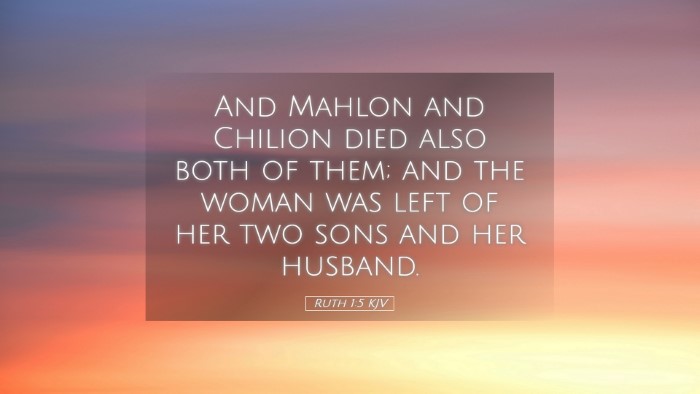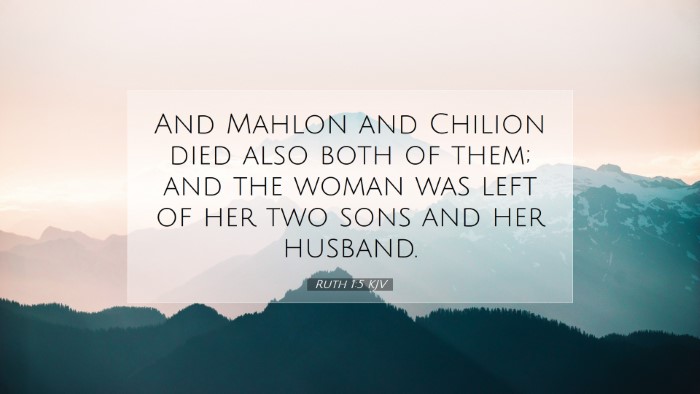Old Testament
Genesis Exodus Leviticus Numbers Deuteronomy Joshua Judges Ruth 1 Samuel 2 Samuel 1 Kings 2 Kings 1 Chronicles 2 Chronicles Ezra Nehemiah Esther Job Psalms Proverbs Ecclesiastes Song of Solomon Isaiah Jeremiah Lamentations Ezekiel Daniel Hosea Joel Amos Obadiah Jonah Micah Nahum Habakkuk Zephaniah Haggai Zechariah MalachiRuth 1:5
Ruth 1:5 KJV
And Mahlon and Chilion died also both of them; and the woman was left of her two sons and her husband.
Ruth 1:5 Bible Commentary
Commentary on Ruth 1:5
Verse: "And Mahlon and Chilion died also both of them; and the woman was left of her two sons and her husband."
Introduction
This poignant verse from the book of Ruth encapsulates profound themes of loss, grief, and divine providence. In the context of ancient Israel, the circumstances faced by Naomi highlight the stark realities of life during a time of famine and the ensuing dislocations of family and faith. Public domain commentaries provide a rich tapestry of insights that can assist pastors, students, theologians, and scholars in gaining a deeper understanding of this significant passage.
Exegesis and Context
Setting the Scene: The book of Ruth begins during the time of the judges, a period marked by social chaos and spiritual decline. Elimelech's decision to move his family to Moab in search of sustenance reflects the desperation faced during a famine. In this light, Ruth 1:5 serves as a crucial turning point in Naomi’s narrative, illustrating the fragility of life and the intricacies of God’s sovereignty over human affairs.
Loss in the Family: Mahlon and Chilion, the sons of Naomi, are introduced in the context of their father's decision to sojourn in Moab. Their premature deaths are emblematic of the challenges faced by families in times of duress. Matthew Henry remarks, “The death of these two sons left Naomi in a most distressed condition, stripped of her immediate family and support.” Both Henry and Adam Clarke emphasize the heart-wrenching nature of Naomi’s losses, which reflect broader human experiences of sorrow and abandonment.
Theological Themes
-
Divine Providence:
Despite the apparent tragedy of this passage, it serves to underscore God’s providential care. Albert Barnes elaborates on the theme of God’s plans revealing themselves through seemingly devastating circumstances. While loss is excruciating, it often paves the way for divine retribution and unexpected blessings, as seen in the later chapters of Ruth.
-
Grief and Resilience:
Naomi stands as a figure representing profound grief yet intricate resilience. The loss of her sons—and consequently her husband—reveals the depth of her suffering, pushing her to return to Bethlehem where hope resides. Adam Clarke highlights Naomi's shift from Moab, symbolizing a journey from despair back to the community of the faithful.
-
Feminine Perspectives:
Naomi’s narrative elevates the experiences of women in biblical literature. Her voice speaks powerfully amongst patriarchal structures, indicating that God’s actions transcend gender boundaries. Reflection upon Naomi's plight leads to a deeper understanding of God’s presence in the lives of women, a theme echoed by Henry, who notes the significance of Naomi's role in the live's of Ruth and Orpah.
Application for Modern Readers
This verse calls readers to reflect on their personal encounters with grief, loss, and the search for hope. For pastors, it provides rich material for sermons focusing on divine providence during suffering. It invites students and theologians to grapple with the roots of human suffering while simultaneously seeking God’s purposes within it.
Encouragement in Suffering: The narrative may encourage believers to view their struggles through the lens of richer biblical themes that include restoration and redemption, reminding them that despair is often the precursor to hope. Albert Barnes notes that “the greater the loss, the greater the opportunity for God to display His faithfulness and restoration.”
Community and Support: Naomi’s return to Bethlehem signifies the importance of community in times of trouble. This teaching prompts modern readers to consider their roles in supporting those who are grieving, echoing the sentiments shared by Matthew Henry regarding the communal aspect of healing in God’s family.
Conclusion
Ruth 1:5, though rich with sorrow, serves as an arresting reminder of God’s sovereignty amidst chaos. Compiled insights from esteemed commentators deepen the understanding of this verse, weaving a narrative that resonates through the ages. For contemporary audiences, the lessons drawn from this poignant moment in Naomi's life illuminate paths of resilience, faith, and renewed hope through God's providence, offering both recognition of human pain and the assurance of divine presence.


